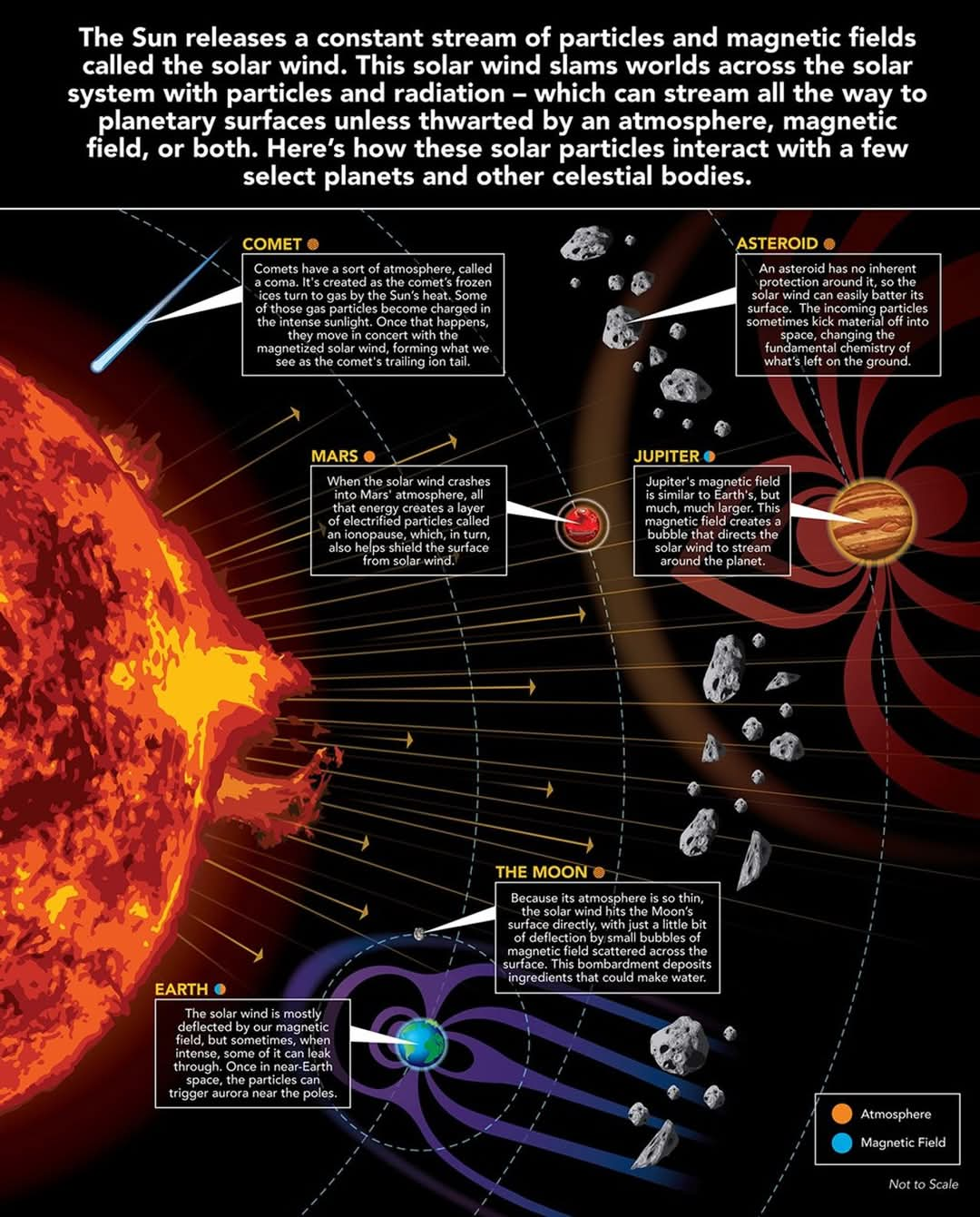태양은 태양계를 가로질러 🌬
태양은 태양계를 가로질러 🌬
태양은 태양풍이라고 불리는 입자와 자기장의 흐름을 방출합니다. 이는 시속 백만 마일이 넘는 속도로 태양 용광로에서 바깥쪽으로 끊임없이 돌진하는 돌풍입니다. 이 바람은 그냥 우주로 사라지지 않습니다. 그것은 그 경로의 모든 것에 부딪힙니다: 행성, 위성, 소행성, 혜성 – 그들 모두는 폭발에 휘말렸습니다.
하지만 모든 세계가 같은 방식으로 돌아가는 것은 아닙니다. 어떤 것들은 방패를 가지고 있습니다.
지구는 운이 좋다.
우리는 핵에서 회전하는 용철에 의해 강력한 자기장을 생성하고 있습니다. 그 들판은 태양풍의 대부분을 반사하여 극지방으로 보내고, 그곳에서 반짝이는 오로라로 하늘을 그립니다. 우리의 두꺼운 대기도 방사선이 표면에 도달하기 전에 흡수하는 데 도움이 됩니다.
화성은 그렇게 운이 좋지 않았어요. 예전에는 자기장이 있었어요. 하지만 그것은 수십억 년 전에 죽었고, 그와 함께 대부분의 화성 대기가 벗겨졌습니다.
이제 태양풍은 도전 없이 매일 그 표면을 터뜨립니다.
달은 더욱 노출되어 있습니다 – 자기장도 없고, 공기도 없습니다. 태양 입자들이 직접 충돌하여 전자 장치를 태우고 미래의 달 탐험가들에게 심각한 위험을 초래할 충전되고 먼지가 많은 환경을 만들었습니다.
그리고 행성의 왕 목성이 있습니다. 태양풍을 튕겨낼 뿐만 아니라 가둡니다.
목성의 자기장은 태양계에서 가장 크며, 수백만 마일에 걸쳐 있습니다. 그것은 전하를 띤 입자들을 퍼올려 거대한 방사선 벨트에 고정시키며, 보이지 않는 총알의 폭풍처럼 행성을 맴돌고 있습니다.
태양풍은 태양계를 미묘하고 강력한 방식으로 형성합니다. 그것은 대기를 훔칩니다. 자기장을 조각합니다. 그것은 우리가 보는 오로라와 방사선 벨트를 활성화합니다.
📸 크레딧: NASA의 고다드 우주 비행 센터/메리 팻 흐리벡-키스
👉 더 많은 우주 만화 및 인포그래픽 참조: www.fromquarkstoquasars.com/
From Quarks to Quasars
Discover the fascinating science of the universe — from quarks to quasars, black holes to galaxies. Our mission is to explain the mysteries of the cosmos and everything in between in a way that's engaging and easy to understand.
www.fromquarkstoquasars.com

The Sun Blows a Stream Across the Solar System 🌬
The Sun releases a stream of particles and magnetic fields called the solar wind – a relentless gust rushing outward from the solar furnace at over a million miles per hour. This wind doesn’t just vanish into space. It slams into everything in its path: planets, moons, asteroids, comets – all of them caught in the blast.
But not all worlds are hit the same way. Some have shields.
Earth is lucky.
We’ve got a magnetic field, a powerful one, generated by the molten iron spinning in our core. That field deflects most of the solar wind, funneling it toward the poles, where it paints the sky with shimmering auroras. Our thick atmosphere helps, too – absorbing the radiation before it reaches the surface.
Mars wasn’t so lucky. It used to have a magnetic field. But it died billions of years ago, and with it, most of the Martian atmosphere was stripped away.
Now the solar wind blasts its surface, unchallenged, day after day.
The Moon is even more exposed – no magnetic field, no air. Solar particles hit it directly, creating a charged, dusty environment that would fry electronics and pose serious hazards for future lunar explorers.
Then there’s Jupiter, king of planets. It doesn’t just deflect the solar wind; it traps it.
Jupiter’s magnetic field is the largest in the solar system, stretching millions of miles. It scoops up charged particles and holds them in massive radiation belts, swirling around the planet like a storm of invisible bullets.
The solar wind shapes the solar system in subtle, powerful ways. It steals atmospheres. It sculpts magnetic fields. It powers the auroras we see and the radiation belts.
📸 Credit: NASA’s Goddard Space Flight Center/Mary Pat Hrybyk-Keith
👉 See more space comics & infographics: www.fromquarkstoquasars.com/
From Quarks to Quasars
Discover the fascinating science of the universe — from quarks to quasars, black holes to galaxies. Our mission is to explain the mysteries of the cosmos and everything in between in a way that's engaging and easy to understand.
www.fromquarkstoquasars.com